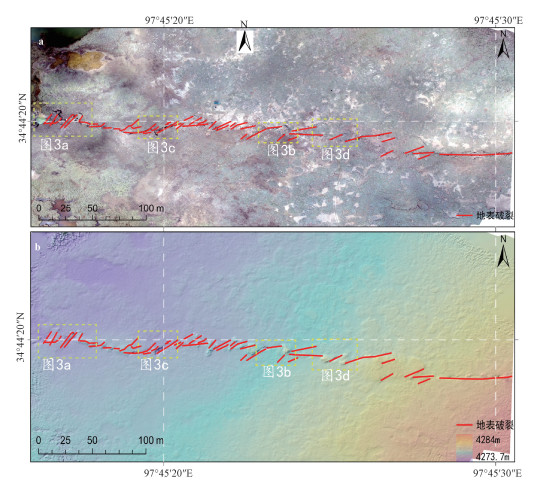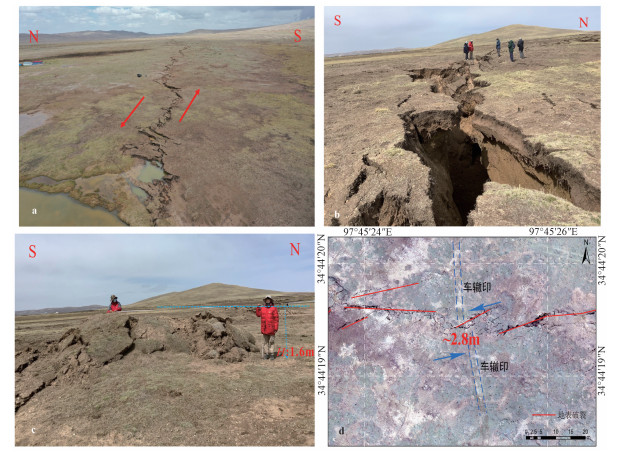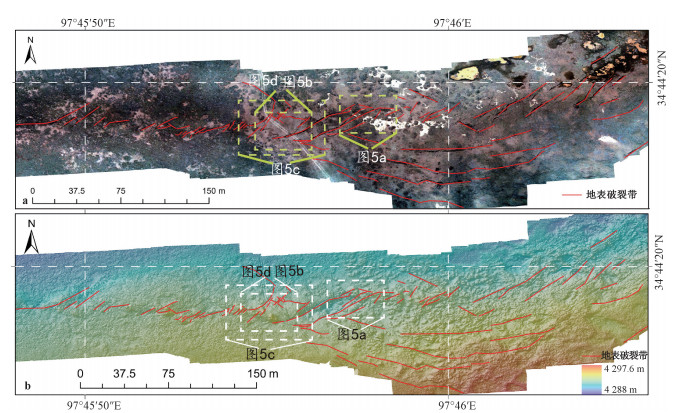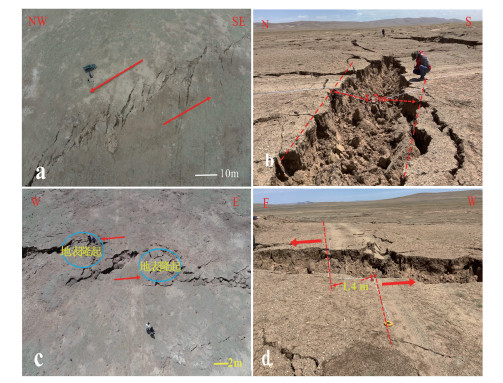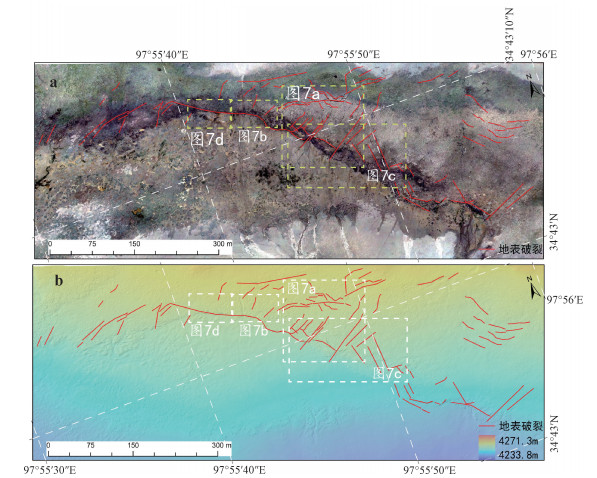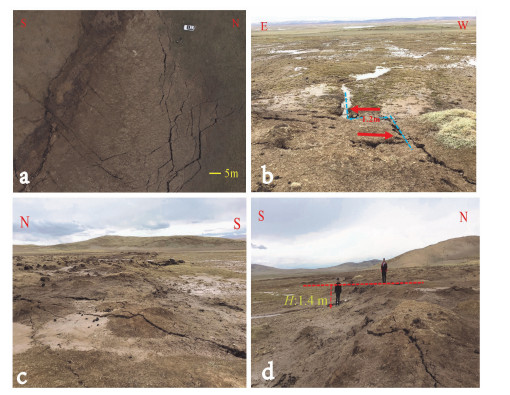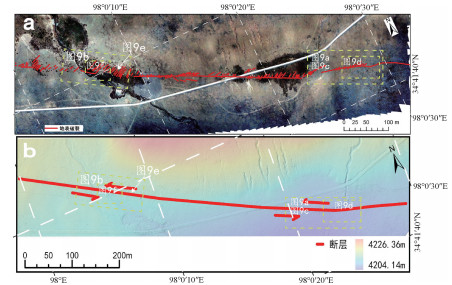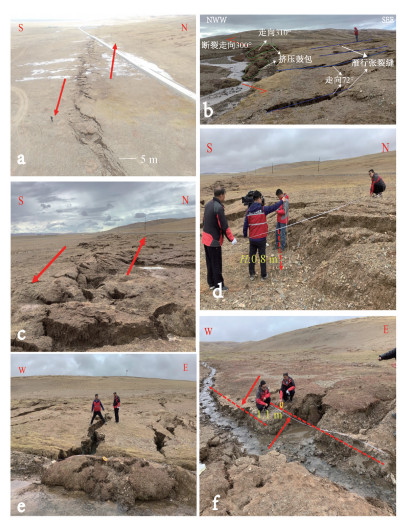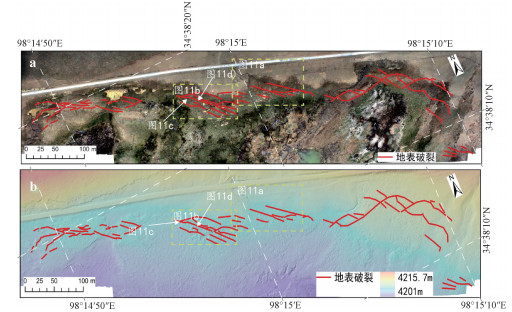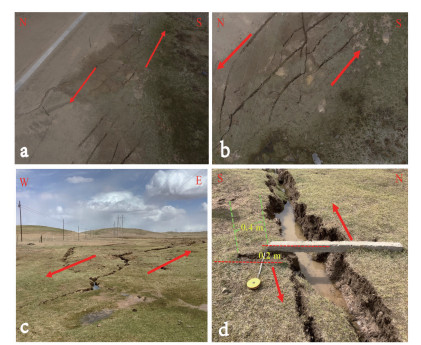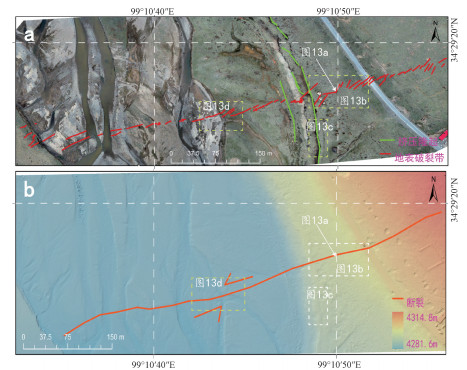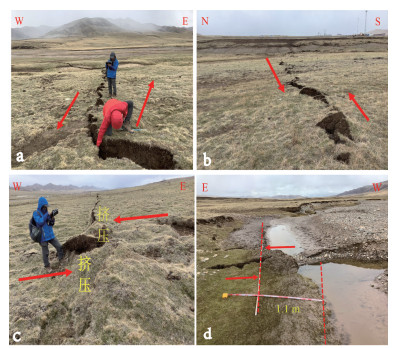Characteristics and causes of coseismic surface rupture triggered by the "5.22" MS 7.4 Earthquake in Maduo, Qinghai, and their significance
-
摘要:
2021年5月22日2时4分在青海省果洛藏族州玛多县境内发生MS7.4级地震,此次玛多MS7.4级地震是2008年汶川MS8.0级大地震之后中国震级最大的一次地震,及时查明其同震地表破裂展布及特征,对于正确认识发震构造和区域防震减灾具有重要意义。根据震后现场调查,结合高分辨率卫星遥感图像的解译分析、余震数据和典型地震地表破裂的无人机低空摄影测量等结果,初步获得了此次地震6处典型地震地表破裂的特征。结果发现:此次玛多地震的地表破裂主要沿已知的东昆仑断裂带的南侧分支断裂昆仑山口-江错断裂的东南段分布,分析表明其中的江错断裂应是此次地震的发震断层;同震破裂的西段总体走向275°~300°,主要表现为挤压鼓包和雁列式张裂隙的斜列组合,其中江错贡麻段至江多村段出现了明显的1.4~0.8 m的垂直位移,指示该段可能具有较明显的正断层成分;中部黄河乡段主要由一系列呈左阶斜列的北西向P剪切裂缝和右阶雁行排列的北东向张裂隙构成,走滑位移较小;而东段地表破裂出现了多个分支,其中北支昌马河段主要由一系列雁行排列的张裂隙组成,总体走向为260°,与断裂西段的走向明显不同;地震造成的最大左旋位移出现在西段的错尔加拉破裂段,约2.8 m,指示此次地震地表破裂带的走滑位移主要呈从西向东的单侧扩展-衰减特征。考虑到此次玛多地震出现在东昆仑主干断裂南侧的巴颜喀拉地块内部,表明该地块内部具有发生7级以上大地震的能力,因此,巴颜喀拉地块内部强震活动的孕震条件和机理应该是未来需要进一步关注的科学问题。
-
关键词:
- 玛多MS7.4级地震 /
- 地震地表破裂 /
- 江错断裂 /
- 东昆仑断裂带 /
- 巴颜喀拉块体
Abstract:An MS 7.4 earthquake occurred in Maduo County, Guoluo Tibetan Prefecture, Qinghai Province at 02:04 on May 22, 2021(Beijing time), which is the largest one in China after the 2008 Wenchuan MS 8.0 earthquake. Finding out the distribution and characteristics of its coseismic surface rupture in time is of great significance for the identification of seismogenic structure, regional earthquake prevention and disaster reduction. Combining the post-earthquake field investigation with the results from the interpretation and analysis of high-resolution satellite remote sensing images, aftershock data and UAV low altitude photogrammetry, we got a preliminary judgment on the characteristics of six typical seismic surface ruptures. Firstly, the surface rupture caused by the Maduo earthquake is mainly distributed along the southeastern segment of the known South Branch of the East Kunlun fault zone, the kunlunshankou-Jiangcuo fault. It indicates that the Jiangcuo fault should be the seismogenic fault of the earthquake. Secondly, the western segment of the coseismic rupture with an overall strike of 275°~300°, is mainly manifested as an inclined combination of compressive bulges and echelon tensile fractures. There is a significant vertical displacement of 1.4~0.8 m between the Jiangcuogongma section and the Jiangduocun section, indicating that the western segment may have obvious normal fault components. The huanghexiang section in the middle is mainly composed of a series of NW-trending P shear fractures with left-order oblique and NE-trending tensile fractures with right-order en echelon, with small strike slip displacements. The Changma reach of the North Branch is mainly composed of a series of en echelon fractures, with the overall strike of 260°, The strike of the fault is obviously different from that of the western segment of the fault. Thirdly, the maximum left lateral displacement caused by the earthquake occurred in the Cuoerjiala rapture section of the western segment, about 2.8 m, indicating that the strike slip displacement of the surface fracture zone of the earthquake is mainly characterized by unilateral expansion attenuation from west to East. The fact that the Maduo earthquake occurred in the Bayan Har block on the south side of the East Kunlun main fault demonstrate the possibility of earthquake with magnitude 7 or above in this block. Therefore the seismogenic conditions and mechanism of strong earthquake activity in the Bayan Har block should be a scientific issue that needs further attention.
-

-
BAI Y J, NI H Y, GE H, 2019. Advances in research on the geohazard effect of active faults on the southeastern margin of the Tibetan Plateau[J]. Journal of Geomechanics, 25(6): 1116-1128, doi: 10.12090/j.issn.1006-6616.2019.25.06.095.(in Chinese with English abstract)
CHEN C Y, REN J W, MENG G J, et al., 2013. Division, deformation and tectonic implication of active blocks in the eastern segment of Bayan Harblock[J]. Chinese Journal of Geophysics, 56(12): 4125-4141, doi: 10.6038/cjg20131217.(in Chinese with English abstract).
DAI H G, 1983. On the Dari earthquake of 1947 in the Qinghai province[J]. Northwestern Seismological Journal, 5(3): 71-77. (in Chinese with English abstract) http://en.cnki.com.cn/Article_en/CJFDTOTAL-ZBDZ198303013.htm
DENG Q D, 2007. Active tectonic map of China (1: 4 million) (attached CD)[M]. Beijing: Seismological Publishing House. (in Chinese)
Department of Earthquake Disaster Prevention, National Earthquake Bureau, 1995. Catalogue of historical strong earthquakes in China[M]. Beijing: Seismological Press: 1-514 (in Chinese).
FU B H, LIN A M, 2003. Spatial distribution of the surface rupture zone associated with the 2001 MS8.1 Central Kunlun earthquake, northern Tibet, revealed by satellite remote sensing data[J]. International Journal of Remote Sensing, 24(10): 2191-2198. doi: 10.1080/0143116031000075918
FU B H, AWATA Y, DU J G, et al., 2005. Late Quaternary systematic stream offsets caused by repeated large seismic events along the Kunlun fault, northern Tibet[J]. Geomorphology, 71(3-4): 278-292, doi: 10.1016/j.geomorph.2005.03.001.
GUO J M, LIN A M, SUN G Q, et al., 2007. Surface ruptures associated with the 1937 M 7.5 Tuosuo Lake and the 1963 M7.0 Alake Lake earthquakes and the paleoseismicity along the Tuosuo Lake segment of the Kunlun fault, northern Tibet[J]. Bulletin of the Seismological Society of America, 97(2): 474-496, doi: 10.1785/0120050103.
JIANG W L, XIE X S, 2006. Characteristics of segments of surface ruptures of strong earthquakes along the East Kunlun active fault zone[J]. Chinese Journal of Geomechanics, 12(2): 132-139. (in Chinese with English abstract)
LI H B, FU X F, VAN DER WOERD J, et al., 2008. Co-seisimic surface rupture and dextral-slip oblique thrusting of the MS8.0 Wenchuan earthquake[J]. Acta Geologica Sinica, 82(12): 1623-1643. (in Chinese with English abstract)
LI H B, PAN J W, SUN Z M, et al., 2015. Seismogenic structure and surface rupture characteristics of the 2014 MS7.3 Yutian earthquake[J]. Acta Geologica Sinica, 89(1): 180-194. (in Chinese with English abstract)
LI H B, PAN J W, SUN Z M, et al., 2021. Continental tectonic deformation and seismic activity: a case study from the Tibetan Plateau[J]. Acta Geologica Sinica, 95(1): 194-213, doi: 10.19762/j.cnki.dizhixuebao.2021051.(in Chinese with English abstract)
LI J J, ZHANG J L, CAI Y Y, 2017. Investigation of historical earthquakes, paleo-earthquakes and seismic gap in the eastern Kunlun fault zone[J]. Earthquake, 37(1): 103-111. (in Chinese with English abstract) http://en.cnki.com.cn/Article_en/CJFDTOTAL-DIZN201701011.htm
LIANG M J, ZHOU R J, YAN L, et al., 2014. The relationships between neotectonic activity of the middle segment of Dari fault and its geomorphological response, Qinghai Province, China[J]. Seismology and Geology, 36(1): 28-38. (in Chinese with English abstract) http://www.bloodjournal.org/content/73/1/141.full.pdf
LIANG M J, YANG Y, DU F, et al., 2020. Late quaternary activity of the central segment of the Dari fault and restudy of the surface rupture zone of the 1947 M7 3/4 Dari earthquake, Qinghai Province[J]. Seismology and Geology, 42(3): 703-714. (in Chinese with English abstract)
LIN A M, FU B H, GUO J M, et al., 2002. Co-seismic strike-slip and rupture length produced by the 2001 MS8.1 central Kunlun earthquake[J]. Science, 296(5575): 2015-2017. doi: 10.1126/science.1070879
LIN A M, RAO G, JIA D, et al., 2011. Co-seismic strike-slip surface rupture and displacement produced by the 2010 MW 6.9 Yushu earthquake, China, and implications for Tibetan tectonics[J]. Journal of Geodynamics, 52(3-4): 249-259. doi: 10.1016/j.jog.2011.01.001
PAN J W, BAI M K, LI C, et al., 2021. Coseismic surface rupture and seismogenic structure of the 2021-05-22 Maduo (Qingha)MS7.4 earthquake[J]. Acta Geologica Sinica, 95(6): 1655-1670, doi: 10.3969/j.issn.0001-5717.2021.06.001.(in Chinese with English abstract)
SUN X Z, XU X W, CHEN L C, et al., 2012. Surface rupture features of the 2010 Yushu earthquake and its tectonic implication[J]. Chinese Journal of Geophysics, 55(1): 155-170, doi: 10.6038/j.issn.0001-5733.2012.01.015.(in Chinese with English abstract)
TAPPONNIER P, MOLNAR P, 1977. Active faulting and tectonics in China[J]. Journal of Geophysical Research, 82(20): 2905-2930. doi: 10.1029/JB082i020p02905
WANG S Y, 1999. Catalogue of modern earthquakes in China[M]. Beijing: China Science and Technology Press. (in Chinese)
WANG W L, FANG L H, WU J P, et al., 2021. Aftershock sequence relocation of the 2021 MS7.4 Maduo Earthquake, Qinghai, China[J]. Science China Earth Sciences, 64(8): 1371-1380, doi: 10.1007/s11430-021-9803-3.(in Chinese with English abstract)
WEN X Z, YI G X, XU X W, 2007. Background and precursory seismicities along and surrounding the Kunlun fault before the MS8.1, 2001, Kokoxili earthquake, China[J]. Journal of Asian Earth Sciences, 30(1): 63-72. doi: 10.1016/j.jseaes.2006.07.008
WEN X Z, 2018. The 2008 Wenchuan, 2013 Lushan and 2017 Jiuzhaigou earthquakes, Sichuan, in the last more than one thousand years of rupture history of the eastern margin of the Bayan Har block[J]. Acta Seismologica Sinica, 40(3): 255-267. (in Chinese with English abstract) http://en.cnki.com.cn/Article_en/CJFDTOTAL-DZXB201803002.htm
WU Z H, ZHAO G M, LONG C X, et al., 2014. The seismic hazard assessment around south-east area of Qinghai-Xizang Plateau: A preliminary results from active tectonics system analysis[J]. Acta Geologica Sinica, 88(8): 1401-1416. (in Chinese with English abstract)
WU Z H, ZHAO G M, LIU J, 2016. Tectonic genesis of the 2015 MS8.1 Nepal great earthquake and its influence on future strong earthquake tendency of Tibetan Plateau and its adjacent region[J]. Acta Geologica Sinica, 90(6): 1062-1085. (in Chinese with English abstract)
XIONG R W, REN J W, ZHANG J L, et al., 2010. Late Quaternary active characteristics of the Gande segment in the Maduo-Gande fault zone[J]. Earthquake, 30(4): 65-73. (in Chinese with English abstract)
XU X W, CHEN W B, MA W T, et al., 2002. Surface rupture of the Kunlunshan earthquake (MS8.1), northern Tibetan plateau, China[J]. Seismological Research Letters, 73(6): 884-892. doi: 10.1785/gssrl.73.6.884
XU X W, CHEN W B, YU G H, et al., 2002. Characteristic Features of the Hoh Sai Hu (Kunlunshan) Earthquake (MS8.1), Northern Tibetan Plateau, China[J]. Seismology and Geology, 24(1): 1-13. (in Chinese with English abstract) http://en.cnki.com.cn/Article_en/CJFDTOTAL-DZDZ200201000.htm
XU X W, CHEN G H, WANG Q X, et al. 2017. Discussion on seismogenic structure of Jiuzhaigou earthquake and its implication for current strain state in the southeastern Qinghai-Tibet Plateau. Chinese J. Geophys, 60(10): 4018-4026, doi: 10.6038/cjg20171028.(in Chinese with English abstract)
YUAN D Y, ZHANG P Z, LIU B C, et al., 2004. Geometrical imagery and tectonic transformation of late quaternary active tectonics in northeastern margin of Qinghai-Xizang Plateau[J]. Acta Geologica Sinica, 78(2): 270-278. (in Chinese with English abstract)
YUAN Z D, LIU-ZENG J, LI X, et al., 2021. Detailed mapping of the surface rupture of the 12 February 2014 Yutian MS7.3 earthquake, Altyn Tagh fault, Xinjiang, China[J]. Science China Earth Sciences, 64(1): 127-147, doi: 10.1007/s11430-020-9673-6.(in Chinese with English abstract)
ZHAN Y, LIANG M J, SUN X Y, et al., 2021. Deep structure and seismogenic pattern of the 2021. 5.22 Madoi(Qinghai) MS7.4 earthquake[J]. Chinese Journal of Geophysics, 64(7): 2232-2252. (in Chinese with English abstract)
ZHANG G M, TIAN Q J, WANG H, 2003. Strong earthquake activities in Kekexili-east Kunlun Mountains active fault zone, northwest China[J]. Earth Science Frontiers, 10(1): 39-46. (in Chinese with English abstract) http://en.cnki.com.cn/Article_en/CJFDTOTAL-DXQY200301007.htm
ZHANG P Z, DENG Q D, ZHANG G M, et al., 2003. Active tectonic blocks and strong earthquakes in the continent of China[J]. Science in China Series D: Earth Sciences, 33(S1): 12-20. (in Chinese with English abstract) http://d.wanfangdata.com.cn/Periodical_zgkx-ed2003z2002.aspx
ZHANG P Z, SHEN Z K, WANG M, et al., 2004. Continuous deformation of the Tibetan Plateau from global positioning system data[J]. Geology, 32(9): 809-812. doi: 10.1130/G20554.1
ZHANG P Z, MOLNAR P, XU X W, 2007. Late Quaternary and present-day rates of slip along the Altyn Tagh Fault, northern margin of the Tibetan Plateau[J]. Tectonics, 26(5): TC5010. http://citeseerx.ist.psu.edu/viewdoc/download;jsessionid=97E870F7460A2603137A62D4B67E9E27?doi=10.1.1.421.9331&rep=rep1&type=pdf
ZHANG P Z, DENG Q D, ZHANG Z Q, et al., 2013. Active faults, earthquake hazards and associated geodynamic processes in continental China[J]. Scientia Sinica Terrae, 43(10): 1607-1620. (in Chinese with English abstract) doi: 10.1360/zd-2013-43-10-1607
ZHANG Y M, LI M F, MENG Y Q, et al., 1996. Research on fault activities and their seismogeological implication in Bayankala Mountain area[J]. Research on Active Fault, 5: 154-171 (in Chinese with English abstract).
ZHAO G Z, UNSWORTH M J, ZHAN Y, et al., 2012. Crustal structure and rheology of the Longmenshan and WenchuanMW 7.9 earthquake epicentral area from magnetotelluric data[J]. Geology, 40(12): 1139-1142. doi: 10.1130/G33703.1
ZHENG W J, YUAN D Y, ZHANG P Z, et al., 2016. Tectonic geometry and kinematic dissipation of the active faults in the northeastern Tibetan Plateau and their implications for understanding northeastward growth of the Plateau[J]. Quaternary Sciences, 36(4): 775-788. (in Chinese with English abstract) http://www.dsjyj.com.cn/EN/Y2016/V36/I4/775
ZHENG W J, ZHANG P Z, YUAN D Y, et al., 2019. Basic characteristics of active tectonics and associamic processes in continental China[J]. Journal of Geomechanics, 25(5): 699-721 DOI: 10.12090/j.issn.1006-6616.2019.25.05.062.(in Chinese with English abstract)
ZHOU C J, Wu Z H, NIMA T, et al., 2014. Qinghai Yushu MS7.1 magnitude earthquake with seismic surface rupture structure geological advisory, 2014, 33 (4): 551-566. (in Chinese with English abstract)
白永健, 倪化勇, 葛华, 2019. 青藏高原东南缘活动断裂地质灾害效应研究现状[J]. 地质力学学报, 25(6): 1116-1128, doi: 10.12090/j.issn.1006-6616.2019.25.06.095. https://journal.geomech.ac.cn/ch/reader/view_abstract.aspx?flag=1&file_no=20190613&journal_id=dzlxxb
陈长云, 任金卫, 孟国杰, 等, 2013. 巴颜喀拉块体东部活动块体的划分、形变特征及构造意义[J]. 地球物理学报, 56(12): 4125-4141, doi: 10.6038/cjg20131217.
戴华光, 1983. 1947年青海达日7 3/4级地震[J]. 西北地震学报, 5(3): 711-77. https://www.cnki.com.cn/Article/CJFDTOTAL-ZBDZ198303013.htm
邓起东, 2007. 中国活动构造图(1: 400万)[M]. 北京: 地震出版社.
国家地震局震害防御司, 1995. 中国历史强震目录[M]. 北京: 地震出版社: 1-514.
江娃利, 谢新生, 2006. 东昆仑活动断裂带强震地表破裂分段特征[J]. 地质力学学报, 12(2): 132-139. doi: 10.3969/j.issn.1006-6616.2006.02.004 https://journal.geomech.ac.cn/ch/reader/view_abstract.aspx?flag=1&file_no=20060204&journal_id=dzlxxb
李海兵, 付小方, VAN DER WOERD J, 等, 2008. 汶川震(MS8.0)地表破裂及其同震右旋斜向逆冲作用[J]. 地质学报, 82(12): 1623-1643. doi: 10.3321/j.issn:0001-5717.2008.12.002
李海兵, 潘家伟, 孙知明, 等, 2015. 2014年于田MS7.3地震地表破裂特征及其发震构造[J]. 地质学报, 89(1): 180-194. https://www.cnki.com.cn/Article/CJFDTOTAL-DZXE201501014.htm
李海兵, 潘家伟, 孙知明, 等, 2021. 大陆构造变形与地震活动: 以青藏高原为例[J]. 地质学报, 95(1): 194-213, doi: 10.19762/j.cnki.dizhixuebao.2021051.
李建军, 张军龙, 蔡瑶瑶, 2017. 东昆仑断裂带历史地震、古地震及地震空区讨论[J]. 地震, 37(1): 103-111. doi: 10.3969/j.issn.1000-3274.2017.01.011
梁明剑, 周荣军, 闫亮, 等, 2014. 青海达日断裂中段构造活动与地貌发育的响应关系探讨[J]. 地震地质, 36(1): 28-38. doi: 10.3969/j.issn.0253-4967.2014.01.003
梁明剑, 杨耀, 杜方, 等, 2020. 青海达日断裂中段晚第四纪活动性与1947年M7 3/4地震地表破裂带再研究[J]. 地震地质, 42(3): 703-714. doi: 10.3969/j.issn.0253-4967.2020.03.011
潘家伟, 白明坤, 李超, 等, 2021. 2021年5月22日青海玛多MS7.4地震地表破裂带及发震构造[J]. 地质学报, 95(6): 1655-1670, doi: 10.3969/j.issn.0001-5717.2021.06.001.
孙鑫喆, 徐锡伟, 陈立春等, 2012. 2010年玉树地震地表破裂带典型破裂样式及其构造意义[J]. 地球物理学报, 55(1): 155-170, doi: 10.6038/j.issn.0001-5733.2012.01.015.
汪素云, 1999. 中国近代地震目录[M]. 北京: 中国科学技术出版社.
王未来, 房立华, 吴建平, 等, 2021. 2021年青海玛多MS7.4地震序列精定位研究[J]. 中国科学: 地球科学, 51(7): 1193-1202, doi: 10.1360/SSTe-2021-0149.
闻学泽, 2018. 巴颜喀拉块体东边界千年破裂历史与2008年汶川、2013年芦山和2017年九寨沟地震[J]. 地震学报, 40(3): 255-267. https://www.cnki.com.cn/Article/CJFDTOTAL-DZXB201803002.htm
吴中海, 赵根模, 龙长兴, 等, 2014. 青藏高原东南缘现今大震活动特征及其趋势: 活动构造体系角度的初步分析结果[J]. 地质学报, 88(8): 1401-1416. https://www.cnki.com.cn/Article/CJFDTOTAL-DZXE201408004.htm
吴中海, 赵根模, 刘杰, 2016. 2015年尼泊尔MS8.1地震构造成因及对青藏高原及邻区未来强震趋势的影响[J]. 地质学报, 90(6): 1062-1085. doi: 10.3969/j.issn.0001-5717.2016.06.002
熊仁伟, 任金卫, 张军龙, 等, 2010. 玛多-甘德断裂甘德段晚第四纪活动特征[J]. 地震, 30(4): 65-73. https://www.cnki.com.cn/Article/CJFDTOTAL-DIZN201004008.htm
徐锡伟, 陈文彬, 于贵华, 等, 2002. 2001年11月14日昆仑山库赛湖地震(MS8.1)地表破裂带的基本特征[J]. 地震地质, 24(1): 1-13. doi: 10.3969/j.issn.0253-4967.2002.01.001
徐锡伟, 陈桂华, 王启欣等, 2017. 九寨沟地震发震断层属性及青藏高原东南缘现今应变状态讨论, 地球物理学报, 60(10): 40184026, doi: 10.6038/cjg20171028.
袁道阳, 张培震, 刘百篪, 等, 2004. 青藏高原东北缘晚第四纪活动构造的几何图像与构造转换[J]. 地质学报, 78(2): 270-278. doi: 10.3321/j.issn:0001-5717.2004.02.017
袁兆德, 刘静, 李雪, 等, 2021. 2014年新疆于田MS7.3地震地表破裂带精细填图及其破裂特征[J]. 中国科学: 地球科学, 51(2): 276-298, doi: 10.1360/SSTe-2020-0100.
詹艳, 梁明剑, 孙翔宇, 等, 2021. 2021年5月22日青海玛多MS7.4地震深部环境及发震构造模式[J]. 地球物理学报, 64(7): 2232-2252. https://www.cnki.com.cn/Article/CJFDTOTAL-DQWX202107002.htm
张国民, 田勤俭, 王辉, 2003. 可可西里-东昆仑活动构造带强震活动研究[J]. 地学前缘, 10(1): 39-46. doi: 10.3321/j.issn:1005-2321.2003.01.005
张培震, 邓起东, 张国民, 等, 2003. 中国大陆的强震活动与活动地块[J]. 中国科学(D辑), 33(S1): 12-20. https://www.cnki.com.cn/Article/CJFDTOTAL-JDXK2003S1001.htm
张培震, 邓起东, 张竹琪, 等, 2013. 中国大陆的活动断裂、地震灾害及其动力过程[J]. 中国科学: 地球科学, 43(10): 1607-1620. https://www.cnki.com.cn/Article/CJFDTOTAL-JDXK201310005.htm
张裕明, 李闵峰, 孟勇琦, 等, 1996. 巴颜喀拉山地区活动断层活动性研究及其地震地质意义[J]. 活动断裂研究, 5: 154-171.
郑文俊, 袁道阳, 张培震, 等, 2016. 青藏高原东北缘活动构造几何图像、运动转换与高原扩展[J]. 第四纪研究, 36(4): 775-788.
郑文俊, 张培震, 袁道阳, 等, 2019. 中国大陆活动构造基本特征及其对区域动力过程的控制[J]. 地质力学学报, 25(5): 699-721, doi: 10.12090/j.issn.1006-6616.2019.25.05.062. https://journal.geomech.ac.cn/ch/reader/view_abstract.aspx?flag=1&file_no=20190506&journal_id=dzlxxb
周春景, 吴中海, 尼玛次仁, 等. 2014. 青海玉树MS7.1级地震同震地表破裂构造[J]. 地质通报, 2014, 33(4): 551-566.
-



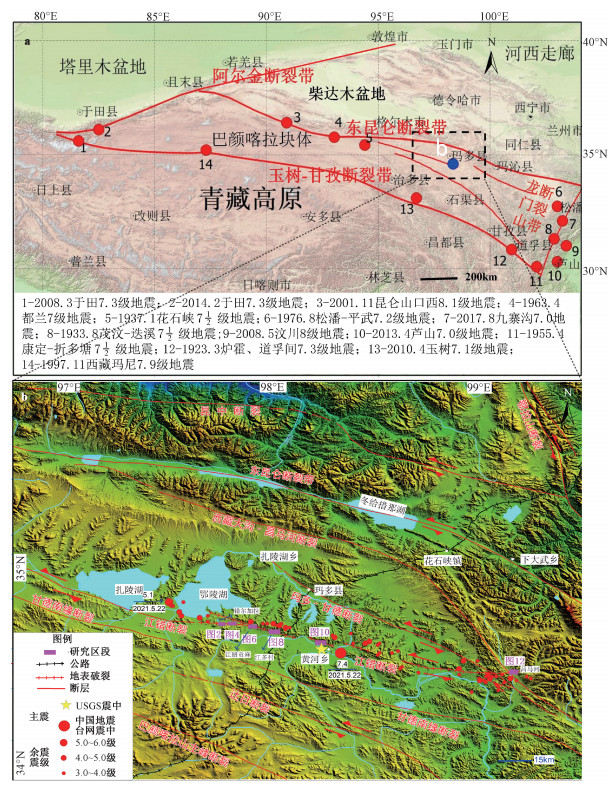
 下载:
下载:
